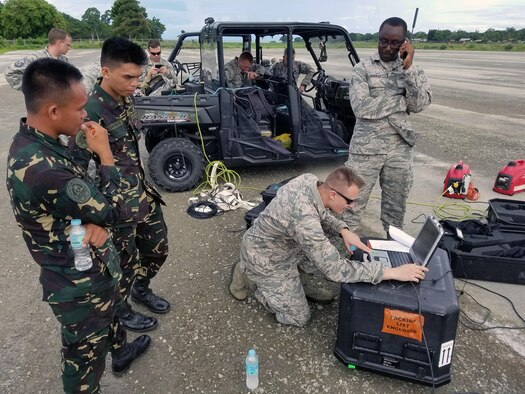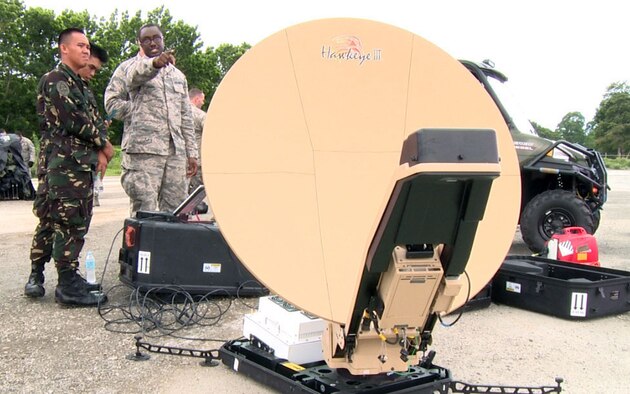
Communication professionals with the 18th Expeditionary Airlift Squadron and the Armed Forces of the Philippines conduct a subject matter expert exchange on a communications flyaway kit during the first day of the current iteration of the Air Contingent at Antonio Bautista Air Base, Philippines, Sept. 26, 2016. The flyaway kit is a rapidly deployable, self-contained satellite communication link that can be used in situations in which military forces must deploy to an area that does not have available communication platforms, particularly in times of natural disaster. The Air Contingent is helping build the capacity of the Philippine Air Force and increases joint training, promotes interoperability and provides greater and more transparent air and maritime situational awareness to ensure safety for military and civilian activities in international waters and airspace. Its missions include air and maritime domain awareness, personnel recovery, combating piracy, and assuring access to the air and maritime domains in accordance with international law. (U.S. Air Force photo by Tech. Sgt. George Maddon)

Philippine Air Force Airman 2nd Class Eldie Bryan Obregon and Airman James Monforte, communications professionals, exchange best practices with U.S. Senior Airman Eric Kimble, 18th Expeditionary Airlift Squadron communications specialist, during a subject matter expert exchange regarding a communications flyaway kit during the first day of the current iteration of the Air Contingent at Antonio Bautista Air Base, Philippines, Sept. 26, 2016. The Air Contingent is helping build the capacity of the Philippine Air Force and increases joint training, promotes interoperability and provides greater and more transparent air and maritime situational awareness to ensure safety for military and civilian activities in international waters and airspace. Its missions include air and maritime domain awareness, personnel recovery, combating piracy, and assuring access to the air and maritime domains in accordance with international law. (U.S. Air Force photo by Tech. Sgt. George Maddon)
Communication professionals from both the United States and the Philippine armed services exchanged best practices during a flyaway communication setup subject matter expert exchange here as part of U.S. Pacific Command’s Air Contingent Sept. 26.
The Air Contingent is helping to build the capacity of the Philippine Air Force and increase joint training, promote interoperability and provide greater and more transparent air and maritime situational awareness to ensure safety for military and civilian activities in international waters and airspace. Its missions include air and maritime domain awareness, personnel recovery, combating piracy, and assuring access to the air and maritime domains in accordance with international law.
“A subject matter expert exchange is the sit-down between us and a partner nation exchanging ideas and best practices,” said Capt. Eduardo Ramirez, 18th Expeditionary Airlift Squadron air advisor. “It’s a great memory to have with them. It just feels good when you feel like they’re welcoming and they’re working with us to exchange ideas.”
During this exchange, U.S. Air Force members from throughout U.S. Pacific Command, with their Philippine counterparts, set up a Hawkeye mobile communications platform on an austere runway, with the Filipinos sharing specific best practices learned from similar deployments throughout their country. The Hawkeye is a rapidly deployable, self-contained satellite communication link. It is used in situations in which military forces must deploy to an area that does not have available communication platforms, particularly in times of natural disaster, when existing infrastructure has been compromised or is nonexistent. Philippine Air Force members could use this technology to establish vital telephone and computer links to higher headquarters or other groups operating in the area during a natural disaster.
The deployment of the air contingent detachment is another example of how the United States and the Philippines are committed to maintaining credible combat power throughout the Indo-Asia Pacific region while the U.S. continues to work closely with the Philippines and our network of partner nations.
“The Philippine service members were very interested in the events of the day,” said Senior Airman Eric Kimble, 18th Expeditionary Airlift Squadron communications specialist who was on the SMEE event. “After a while, they got acquainted with the system and were asking more questions, wanting to know more about it. This is one of those steps integrating our communications knowledge, integrating our military knowledge, and with that, we build strong relationships and ties.”
The communications exchange is just one way the United States is exercising continued presence and demonstrating our commitment to our partners and allies in the region.
Other planned events are mass casualty response exchanges, security forces best practices discussions and maintenance-based exchanges between the two countries.
http://www.pacaf.af.mil/News/ArticleDisplay/tabid/377/Article/964207/us-philippine-airmen-increase-interoperability-during-subject-matter-exchange.aspx

No comments:
Post a Comment
Note: Only a member of this blog may post a comment.